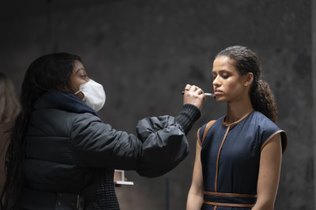Overview of the role
Hair and make-up artists work under the instruction of the hair and make-up designer or supervisors. They are expected to have an extensive range of skills in both hair and make-up, including modern-day and period hair and make-up, wigs, facial, possibly hair cutting, casualty work and prosthetics.
Download the PDF version of this skills checklist here: Hair and Make-up Artist Skills Checklist.
Core responsibilities
These core responsibilities are provided as a guide and are not exhaustive. The exact responsibilities in a particular job will vary depending on the scale/ budget band / genre of the production.
- Read the scripts and the designer’s and/or supervisor's script break downs and other information
- Research the style, genre and or period of the production
- Break down the script in order to get a better understanding of the script and what may be required in terms of hair and make-up, particularly for the artists / performers who they may have allocated to them
- Undertake various tasks assigned by the designer or supervisors, such as to help with artist / performer fittings, shopping for stock, setting up the make-up trucks or rooms, assisting with paperwork, dress wigs, facial, or preparing prosthetics
- Undertake the fitting or test for the artists / performers they will be looking after during the production
- Undertake crowd fittings either in pre-production or during production. Crowd fittings may also occur at the unit or crowd base during a filming
- Record on the fittings sheets details of the hair and make-up carried out, including haircuts, hair colouring, wig stock numbers, facial, or tattoos, so this can be entered on the fitting sheet for that artist / performer along with clear 360-degree photos and any other photos that may be required, such as existing tattoos
- Organise a set bag for each individual that the artist is responsible for, if one hasn’t already been made
- May be required to carry out or assist in various administration tasks
- May be required to carry out or assist in inventories of stock, and the designer’s own supplied stock and kit, and also ensuring all stock and equipment is stored correctly
- May also carry out or assist with ordering of stock and hired-in equipment
- If no fittings or tests have been carried out and it’s a ‘fit on the day’, ensure that what is planned and any requirements are discussed in advance with the designer
- When it is a ‘fit on the day’, or there has been a costume, hair or make-up change, ensure a member of the team documents the hair and make-up notes, and also ensures 360-degree photographs (front, back, each side, ideally in daylight) are taken. This is in addition to any continuity photographs taken on set during the day
- Carry out hair and make-up required using appropriate techniques
- Keep abreast of all continuity and hair and make-up changes for their artists / performers
- Travel to set with their artist / performer and possible others, and standby on them throughout the day’s filming, ensuring their artists are checked when required, hair and make-up changes carried out, and that continuity photographs are taken, and continuity notes recorded if required
- Check that the trainees and / or juniors have everything prepared and ready in advance for the de-rig of the artists, ensuring all stations are tidy and have required products and materials, including hot towels for the de-rig
- Check if any wigs or facial removed will need the lace cleaning and then blocking and redressing, as required
- Check small prosthetic pieces that may be required for the following day are made in advance
Skills
Check out role specific skills, transferable skills and attributes for the role of hair and make-up artist.
- Monitoring and logging the hair and make-up continuity of artists / performers
- Experience of applying make-up and prosthetics for screen productions
- Experience of dressing and styling hair for screen productions
- Communication: communicate the hair and make-up department’s requirements to others, ensuring good communication at all times within the department and with artists / performers
- Teamwork: collaboration within own department and with others
- Problem-solving: dealing with obstacles or issues that may arise, finding solutions and contingency planning
- Organisation: organisation is vital to the department to ensure it runs smoothly and efficiently
- Time management: have the ability to work to the pre-determined deadlines
- Adaptability: have the ability to deal with ever changing schedules and be able to adapt accordingly
- Resilience and enthusiasm: adapt positively to changing work priorities and patterns, ensuring deadlines continue to be met. Proactive and explores new ideas and non-standard ways of working which will enhance and deliver the best results for the production
- Ethics and integrity: honest and principled in all of their actions and interactions. Respectful and inclusive of others, and meets the ethical requirements of their profession
- Flexibility: willing to both listen and learn and to accept changing priorities and working requirements and has the flexibility to maintain high standards in a changing production environment
Check out the accredited qualifications for the role of hair and make-up artist.
Refer to the stage and screen focused hair and make-up qualifications or beauty industry focused hair and make-up qualifications as detailed in the hair and make-up junior skills checklist.
- Higher National Certificate Hairdressing at SCQF Level 7
- Level 4 Diploma in Advanced Techniques and Management Practice in Hairdressing
- Level 4 Diploma in Management Practice and Advanced Techniques in the Hair and Beauty Sector
- Level 4 Diploma in Toni & Guy Hair Styling and Technical
- Level 2 Award in Health and Safety for the Hair and Beauty Sector
